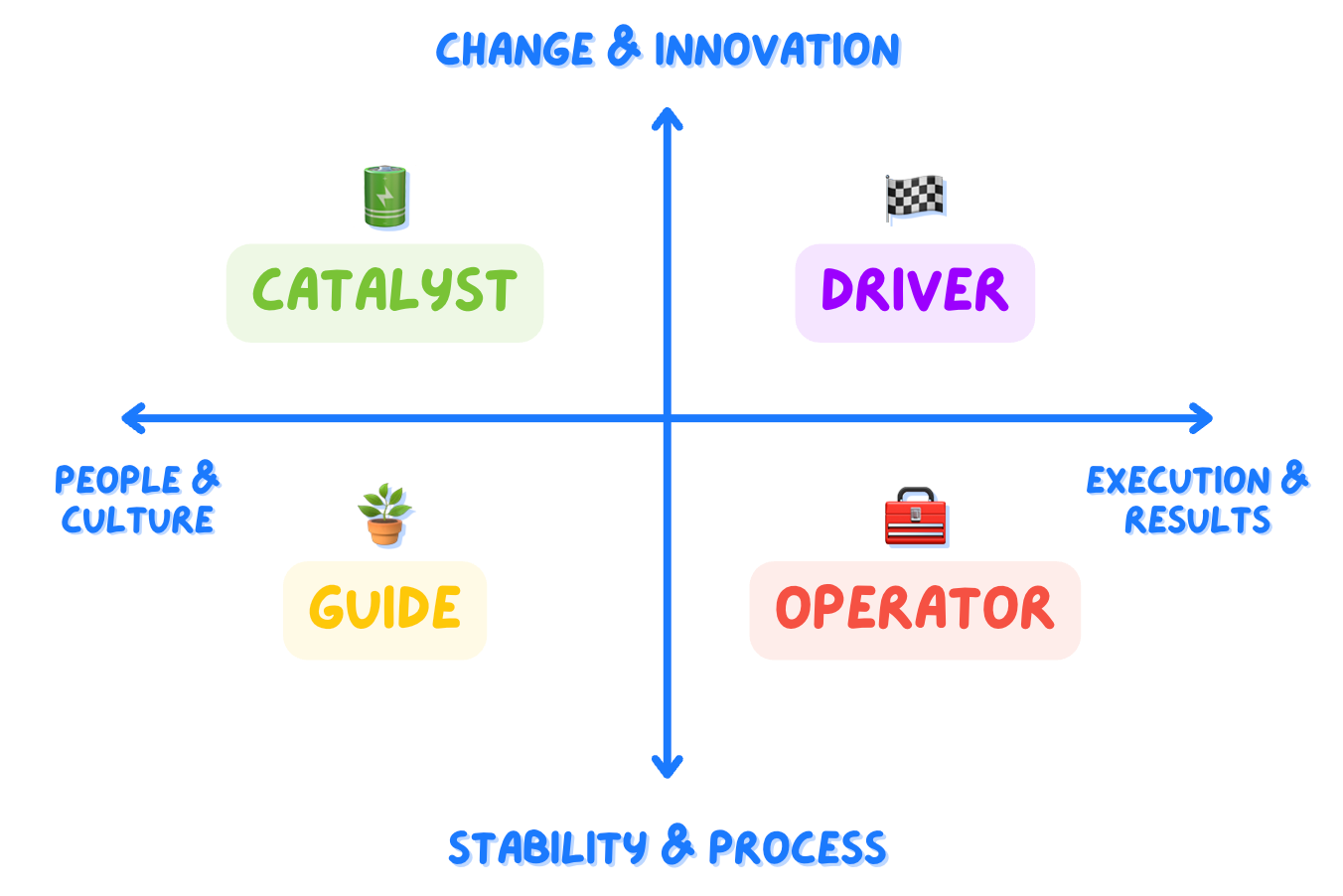Hey, Luca here, welcome to a weekly edition of the💡 Monday Ideas 💡 from Refactoring! To access all our articles, library, and community, subscribe to the full version:
Resources: 🏛️ Library • 💬 Community • 🎙️ Podcast • 📣 Advertise
1) 🔒 The startup guide to global compliance
This idea is brought to you by today’s sponsor, Vanta!
Growing across markets? This guide helps you cut through SOC 2, ISO 27001, GDPR, and more — so you only focus on what matters for your stage and scale.
Built for startups that need to move fast, not hire a full-time compliance team 👇
2) 🔖 The Engineering Manager Quadrants
In summer we published one of our deeper articles ever, about engineering manager archetypes. It was the result of months of work by my friend Thiago Ghisi.
The main idea is that managers naturally fall along two axes: how they handle Stability vs Change, and whether they default to Execution vs People.
Putting them on a 2×2 matrix, you can identify four leadership archetypes:
🧰 Operator (Stability + Execution) — focused on predictability, process discipline, and operational control. Think robust project plans, clear milestones, and minimal surprises.
🪴 Guide (Stability + People) — prioritizes nurturing, safety, and team culture. This is the mentor figure, ensuring strong relationships, skill development, and psychological safety above all.
🏁 Driver (Change + Execution) — embodies velocity, ambition, and technical or product transformation. These managers thrive on pushing the envelope, delivering new features or bold initiatives quickly.
🔋 Catalyst (Change + People) — focuses on storytelling, cultural shifts, and strategic influence. Catalysts excel at inspiring teams to embrace new directions and adapt to evolving org priorities.
By identifying where you land, you can see how you naturally handle the flux that defines engineering management—and consciously tweak your style when circumstances demand it.
↔️ The Horizontal Axis — reveals whether you rely on execution and hard power, or if you scale by uplifting people, culture, and soft power.
↕️ The Vertical Axis — measures how you approach the system: do you optimize it for steadiness or keep pushing it to evolve?
These aren’t rigid labels, but rather your center of gravity. Great EMs can shift between quadrants as situations demand, but knowing your home quadrant helps you 1) leverage your strengths and 2) partner with others whose archetypes complement yours.
You can find the full piece below 👇
3) 🔄 The Four Stages of Habits
There is a small handful of books that were not only enjoyable the first time I read them, but over time grew into reference books that I go back to for advice, guidance, or just a refresher.
One of these is Atomic Habits by James Clear. I think about Atomic Habits every time I feel some of my routines is falling through the cracks, or I am not able to follow through some commitment.
One of the most useful ideas in the book is that habits are made up of four stages:
🟣 Cue — the trigger that makes the brain recognize an opportunity for reward.
🔴 Craving — the desire to achieve the reward. Occurs once the cue indicates the opportunity.
🟡 Response — the action you take to get the reward.
🟢 Reward — the resulting benefit gained from the response.
For a habit to stick, you need all four. You can also organize these stages into two phases: problem + solution:
Create the problem → Cue + Craving
Create the solution → Response + Reward
So, the key to building good habits is to act on those stages:
Cue → make it obvious
Craving → make it attractive
Response → make it easy
Reward → make it satisfying
Likewise, if you want to break bad habits you do the reverse:
Cue → make it invisible
Craving → make it unattractive
Response → make it difficult
Reward → make it unsatisfying
I wrote a full review + summary of Atomic Habits in this previous newsletter edition 👇
4) 🎙️ Junior devs turn into senior devs
At the beginning of the year I interviewed one of my heroes, Martin Fowler, on the podcast.
We discussed, among other things, the way AI may affect how we grow developers, and Martin said a simple thing that I keep thinking about:
“One of the most important properties of a junior developer is the fact that you can turn them into a senior developer.”
For as trivial as this observation might seem, it feels to me that many companies don’t fully grasp the reality of it.
Having a pipeline that reliably turns junior engineers into seniors over a few years is an incredible asset, that single-handedly solves 80% of your hiring problems. And given that hiring is, quite often, the #1 problem for engineering teams, I would say this is a pretty important topic.
Junior engineers are cheaper and faster to hire than seniors, you can create reliable pipelines to do so (e.g. from universities, bootcamps, and more), and you can grow them exactly into what you need them to be.
Here is the full interview with Martin:
You can also find it on 🎧 Spotify and 📬 Substack
And that’s it for today! If you are finding this newsletter valuable, consider doing any of these:
1) 🔒 Subscribe to the full version — if you aren’t already, consider becoming a paid subscriber. 1700+ engineers and managers have joined already! Learn more about the benefits of the paid plan here.
2) 📣 Advertise with us — we are always looking for great products that we can recommend to our readers. If you are interested in reaching an audience of tech executives, decision-makers, and engineers, you may want to advertise with us 👇
If you have any comments or feedback, just respond to this email!
I wish you a great week! ☀️
Luca





